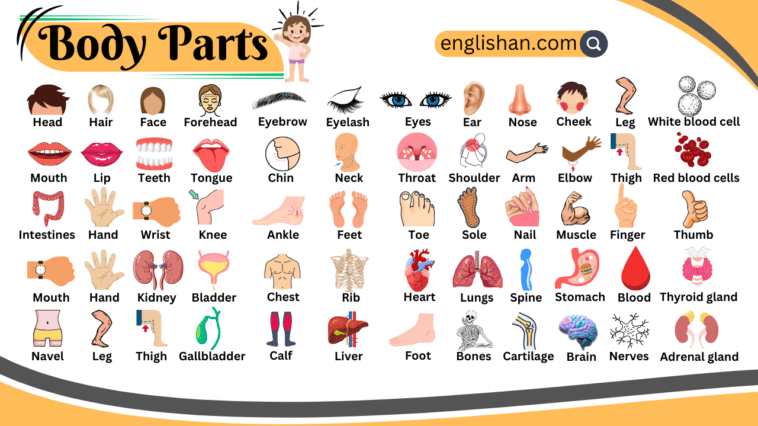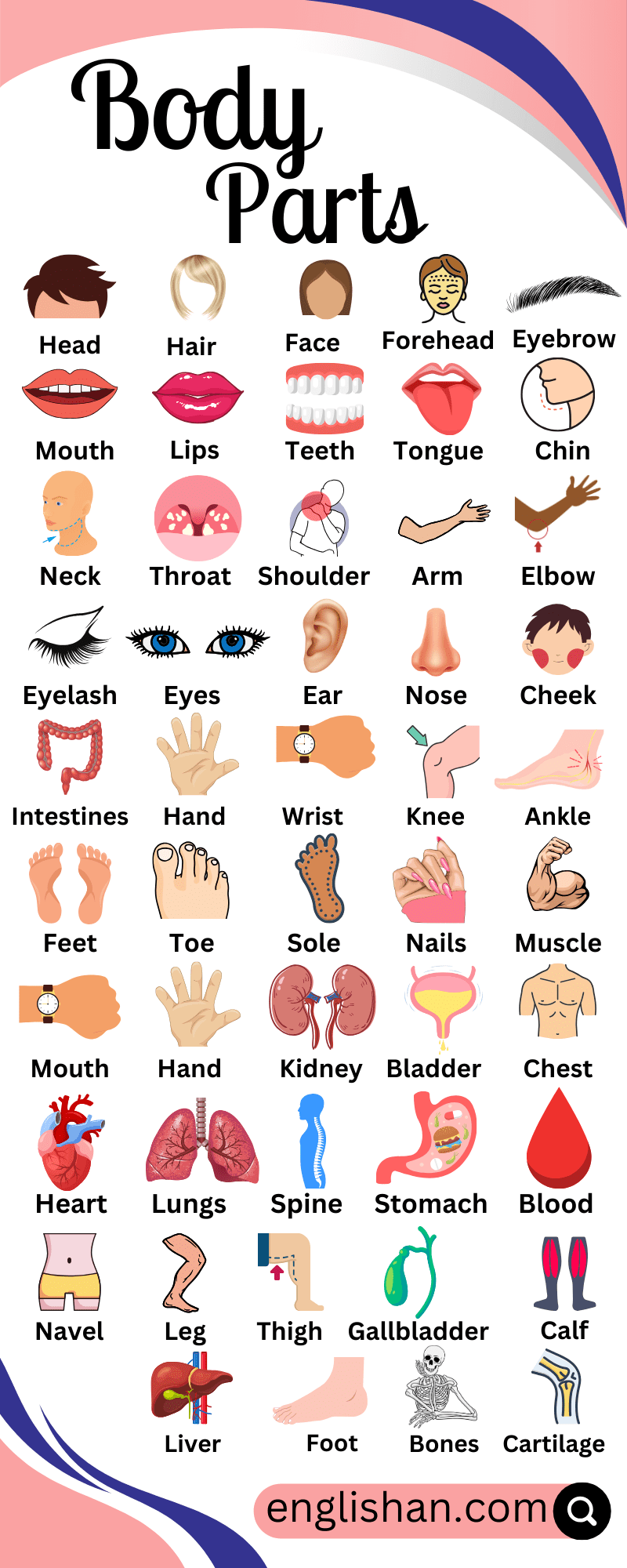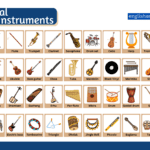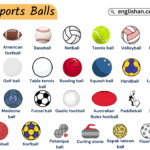Body Parts! The human body is composed of various parts, organs, and systems that work together to maintain life and perform various functions. Each part plays a unique role, and their harmonious functioning ensures our survival and overall well-being. Understanding and caring for these parts is crucial for maintaining a healthy and vibrant life.
Learning about body parts is crucial for several reasons, encompassing both practical and educational aspects.
External Parts of Body Names
The external parts of the human body, often referred to as the “external anatomy,” are the visible and tangible structures that make up the outer appearance of an individual. Here are some of the key external parts of the human body:
Head: Contains the brain, eyes, ears, nose, mouth, and hair.
Forehead: The frontal area of the head, above the eyes and between the temples.
Hair: Hair is a filamentous structure that grows from follicles in the skin of mammals, including humans.
Face: The face is a prominent and highly expressive part of the human body, serving various essential functions.
Eyes: The eyes are responsible for vision and contain various structures such as the cornea, iris, pupil, and retina.
Eyes: The eyes are responsible for vision and contain various structures such as the cornea, iris, pupil, and retina.
Ears: The ears are responsible for hearing and balance. They consist of the outer ear, middle ear, and inner ear.
Nose: The nose is involved in the sense of smell (olfaction) and plays a role in breathing.
Mouth: The mouth includes the lips, teeth, tongue, and gums. It is used for speaking, eating, and breathing.
Cheeks: The fleshy areas on the sides of the face below the eyes and beside the nose.
Chin: The lower part of the face, below the mouth, and above the neck.
Jaw: The jawbone (mandible) is the lower part of the skull that holds the teeth and is essential for chewing and speaking.
Teeth: The teeth are found in the mouth and are used for biting, chewing, and grinding food.
Tongue: The tongue is a muscular organ in the mouth responsible for tasting, swallowing, and speech.
Lips: The lips surround the mouth opening and have sensory receptors for touch and temperature.
Neck: Connects the head to the torso and contains the throat.
Shoulders: The shoulders are the junction between the arms and the torso, consisting of the collarbones (clavicles) and shoulder blades (scapulae).
Chest: Houses the heart and lungs.
Elbow: The elbow is a complex joint that connects the upper arm (humerus) and the two bones of the forearm.
Wrist: The wrist is a complex joint that connects the hand to the forearm
Hands: Hands are a vital part of the human body, and they serve a wide range of functions. Here
Palm: The palm of the hand is the central, fleshy part located on the underside of the hand.
Fingers: The hand has five fingers, each with several components:
Nails: Fingernails are hard, protective structures at the tips of the fingers.
Legs: The legs are essential parts of the human body responsible for supporting our weight, enabling mobility, and facilitating various movements.
Thighs: The thighs are the upper portions of the legs, located between the hip and knee joints
Knees: The knees are complex hinge joints that connect the thighs to the lower legs.
Ankles: The ankles are joints that connect the lower leg to the foot.
Toes: The toes are the digits at the front of the foot.
Heel: The heel is the rear part of the foot and provides support and stability when standing and walking.
Internal Parts of Body Names
The human body is composed of various internal parts, organs, and systems that work together to maintain life and perform various functions. Here are some of the key internal parts of the human body:
Brain: The central control center for the body.
Spinal Cord: Transmits nerve signals between the brain and the body.
Heart: Pumps blood to circulate throughout the body.
Lungs: Facilitate the exchange of oxygen and carbon dioxide during breathing.
Liver: Performs various metabolic functions and detoxifies the blood.
Kidneys: Filter waste products from the blood and regulate fluid balance.
Stomach: Digests food with stomach acids and enzymes.
Intestines: Absorb nutrients from digested food.
Pancreas: Produces insulin and regulates blood sugar levels.
Gallbladder: Stores and releases bile for digestion.
Bladder: Stores urine before elimination.
Reproductive Organs: In males, the reproductive organs include the testes, which produce sperm, and in females, the reproductive organs include the ovaries, fallopian tubes, uterus, and vagina.
Thyroid Gland: The thyroid gland produces hormones that regulate metabolism.
Adrenal Glands: The adrenal glands produce hormones such as adrenaline and cortisol, which play a role in the body’s response to stress.
Thymus Gland: The thymus gland is involved in the development of the immune system, particularly in early life.
Pituitary Gland: The pituitary gland controls the release of hormones from other endocrine glands and regulates various bodily functions.
Bone Marrow: Bone marrow is responsible for producing blood cells, including red blood cells, white blood cells, and platelets.
Muscles: Muscles throughout the body allow for movement, posture, and the generation of force.
Nervous System: The nervous system includes the brain, spinal cord, and nerves, which transmit signals throughout the body to control various functions and responses.
Blood Vessels: Blood vessels, including arteries, veins, and capillaries, transport blood, oxygen, and nutrients throughout the body.
Parts of Sense:
Human beings have five primary senses, each of which plays a crucial role in perceiving and interacting with the surrounding environment. Here are the parts associated with each of these senses:
Sight (Vision):
Eyes: The eyes are the sensory organs responsible for sight. They consist of various parts, including the cornea, lens, retina, and optic nerve.
Hearing (Audition):
Ears: The ears are responsible for hearing and balance. They consist of three main parts: the outer ear the middle and the inner ear.
Taste (Gustation):
Taste Buds: Taste buds are found on the tongue, as well as on the roof of the mouth and in the throat.
Smell (Olfaction):
Nose: The sense of smell is primarily located in the olfactory epithelium, which is a specialized tissue in the upper part of the nasal cavity.
Touch (Tactile Perception):
Skin: The skin is the body’s largest sensory organ and contains numerous receptors for touch, pressure, temperature, and pain.
List of Parts of Body Names:
- Head
- Face
- Eyes
- Ears
- Nose
- Mouth
- Neck
- Chest
- Abdomen
- Back
- Arms
- Hands
- Fingers
- Legs
- Feet
- Toes
- Skin
- Scalp
- Hair
- Lips
- Teeth
- Tongue
- Throat
- Shoulders
- Elbows
- Wrists
- Hips
- Knees
- Ankles
- Heels
- Toenails
- Fingernails
- Heart
- Lungs
- Liver
- Kidneys
- Stomach
- Intestines (small and large)
- Pancreas
- Gallbladder
- Bladder
- Uterus (in females)
- Ovaries (in females)
- Testes (in males)
- Prostate (in males)
- Spleen
- Appendix
- Spinal Cord
- Brain
- Nerves
- Blood Vessels
- Veins
- Arteries
- Lymph Nodes
- Lymphatic System
- Reproductive Organs
- Adrenal Glands
- Pituitary Gland
- Thyroid Gland
- Parathyroid Glands
- Adipose Tissue (Fat)
- Muscles
- Bones
- Joints
- Cartilage
- Tendons
- Ligaments
- Tonsils
- Larynx (Voice Box)
- Trachea (Windpipe)
- Esophagus
- Diaphragm
- Ribcage
- Pelvis
- Blood
- Plasma
- Red Blood Cells
- White Blood Cells
- Platelets
- Immune System
- Respiratory System
- Cardiovascular System
- Digestive System
- Endocrine System
- Nervous System
- Skeletal System
- Muscular System
- Urinary System
- Lymphatic System
- Reproductive System
- Integumentary System (Skin, Hair, Nails)
- Gastrointestinal Tract
- Respiratory Tract
- Circulatory System
- Vertebral Column (Spine)
- Pelvic Bone
- Cranial Bones
- Facial Bones
- Rib Bones
- Hand Bones
You May Also Like




